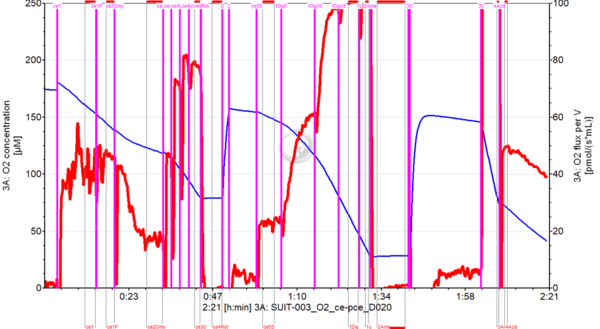Description
Abbreviation: CCVP
Reference: A SUIT-003 - Coupling-control protocol and respirometric cell viability test; ce: living cells, pce: permeabilized cells
SUIT number: D020_ce1;ce1P;ce2Omy;ce3U;ce4Rot;ce5S;1Dig;1c;2Ama;3AsTm;4Azd
O2k-Application: O2
SUIT-003 O2 ce-pce D020 is designed to study coupling control and plasma membrane permeability of living cells. Respiratory capacities are tested in a sequence of coupling states: ROUTINE, LEAK respiration and Electron transfer pathway. To study LEAK respiration, the phosphorylation system is inhibited by oligomycin. The final concentration of oligomycin has to be carefully optimized for various cell types, to minimize the inhibitory effect on the electron transfer system which would lead to an underestimation of ET capacity. The viability index, VI, in the simple CCVP-ce (SUIT-003 O2 ce-pce D020) may be underestimated, if succinate uptake in the living cells proceeds throught the dicarboxylate carrier of the plasma membrane. CCVP-ce can be extended by the Complex IV module.
Communicated by Doerrier C, Cardoso LH, Gnaiger E (last update 2019-09-24)
Representative traces
Steps and respiratory states
| Step | State | Pathway | Q-junction | Comment - Events (E) and Marks (M) |
|---|---|---|---|---|
| ce1 | ROUTINE | ce1
| ||
| ce1P | ROUTINE | ce1;ce1P
| ||
| ce2Omy | L(Omy) | ce1;ce1P;ce2Omy
| ||
| ce3U | E | ce1;ce1P;ce2Omy;ce3U
| ||
| ce4Rot | ROX | ce1;ce1P;ce2Omy;ce3U;ce4Rot
|
| Step | State | Pathway | Q-junction | Comment - Events (E) and Marks (M) |
|---|---|---|---|---|
| ce5S | ce1;ce1P;ce2Omy;ce3U;ce4Rot;ce5S
| |||
| 1Dig* | SE | S | CII | ce1;ce1P;ce2Omy;ce3U;ce4Rot;ce5S;1Dig
|
| 1c | SE | S | CII | ce1;ce1P;ce2Omy;ce3U;ce4Rot;ce5S;1Dig;1c
|
| 2Ama | ROX | ce1;ce1P;ce2Omy;ce3U;ce4Rot;ce5S;1Dig;1c;2Ama
|
| Step | Respiratory state | Pathway control | ET-Complex | Comment |
|---|---|---|---|---|
| ## AsTm | AsTmE | CIV | CIV | |
| ## Azd | CHB |
- Bioblast links: SUIT protocols - >>>>>>> - Click on [Expand] or [Collapse] - >>>>>>>
- Coupling control
- Pathway control
- Main fuel substrates
- » Glutamate, G
- » Glycerophosphate, Gp
- » Malate, M
- » Octanoylcarnitine, Oct
- » Pyruvate, P
- » Succinate, S
- Main fuel substrates
- Glossary
Strengths and limitations
- The SUIT-003 O2 ce-pce D020 is a coupling-control protocol for living cells. The total cell count (Nce) is the sum of viable cells (Nvce) and dead cells (Ndce).
- For determination of respirometric viability index, it is assumed that both viable and dead cells contain functional mitochondria.
- When the cell viability test module is not incorporated into the experiment, Complex III inhibitors can be used instead of rotenone to reach Rox.
- + Respirometric cell viability test correlates with other cell viability quantification methods.
- + With the extended module, S-ET capacity can be assessed after the performance of the coupling-control protocol, as well as outer mt-membrane integrity with the addition of cytochrome c.
- + CIV activity can also be measured after the cell viability test module.
- + Flexibility of experiment duration: from 1 hour (cell coupling-control protocol) to 2 and a half hours (cell coupling control, cell viability test module and CIV module).
- - Cells with a cell membrane succinate transporter are not suitable for the viability test.
- - Pathological profiles could hinder the cell viability test.
- - Careful washing is required after the experiment to avoid carry-over of inhibitors and uncoupler.
- - The concentration of oligomycin has to be carefully tested to avoid inhibitory effects in the evaluation of the ET capacity.
Compare SUIT protocols
Chemicals and syringes
| Step | Chemical(s) and link(s) | Comments |
|---|---|---|
| ce1P | Pyruvate (P) | |
| ce2Omy | Oligomycin (Omy) | |
| ce3U | Carbonyl cyanide m-chlorophenyl hydrazone, CCCP (U) | Can be substituted for other uncoupler |
| ce4Rot | Rotenone (Rot) | |
| ce5S | Succinate (S) | |
| 1Dig | Digitonin (Dig) | |
| 1c | Cytochrome c (c) | |
| 2Ama | Antimycin A (Ama) |
| Step | Chemical(s) and link(s) | Comments |
|---|---|---|
| ## AsTm | Ascorbate (As) and TMPD (Tm) | |
| ## Azd | Azide (Azd) |
- Suggested stock concentrations are shown in the specific DL-Protocol.
References
| Year | Reference | Organism | Tissue;cell | |
|---|---|---|---|---|
| Doerrier 2018 Methods Mol Biol | 2018 | Doerrier C, Garcia-Souza LF, Krumschnabel G, Wohlfarter Y, Mészáros AT, Gnaiger E (2018) High-Resolution FluoRespirometry and OXPHOS protocols for human cells, permeabilized fibers from small biopsies of muscle, and isolated mitochondria. Methods Mol Biol 1782:31-70. https://doi.org/10.1007/978-1-4939-7831-1_3 | Human Mouse Rat Saccharomyces cerevisiae | Heart Skeletal muscle Endothelial;epithelial;mesothelial cell Blood cells HEK Platelet |
| Stadlmann 2006 Cell Biochem Biophys | 2006 | Stadlmann S, Renner K, Pollheimer J, Moser PL, Zeimet AG, Offner FA, Gnaiger E (2006) Preserved coupling of oxidative phosphorylation but decreased mitochondrial respiratory capacity in IL-1ß treated human peritoneal mesothelial cells. Cell Biochem Biophys 44:179-86. | Human | Endothelial;epithelial;mesothelial cell |
MitoPedia concepts:
SUIT protocol,
SUIT A,
Find
MitoPedia methods:
Respirometry



